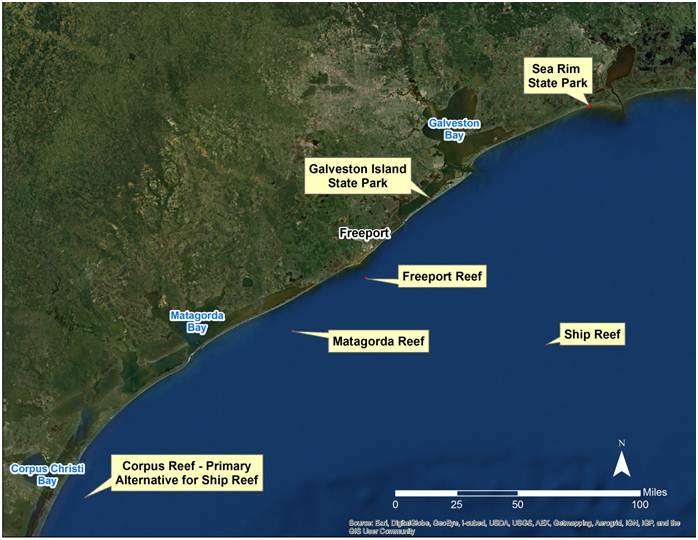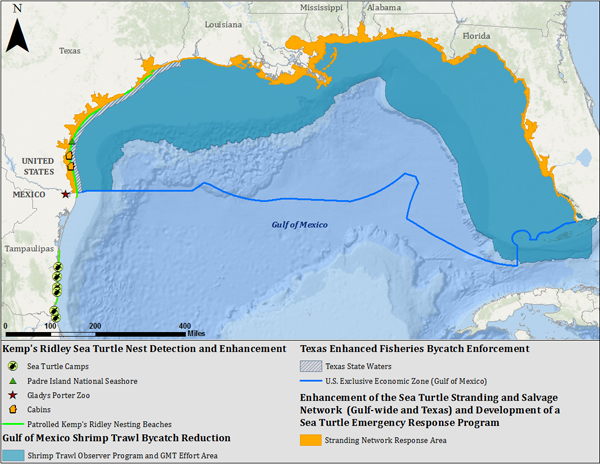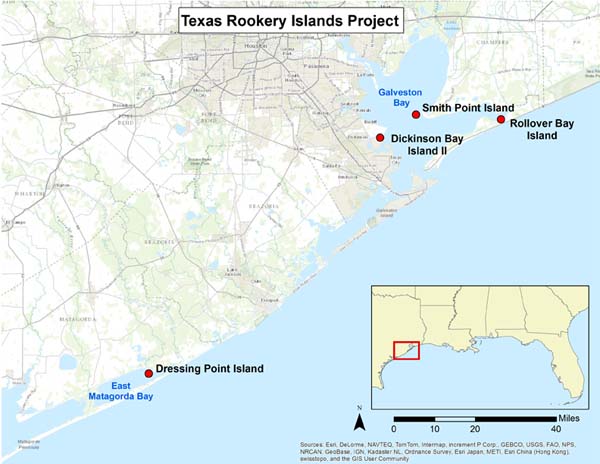- Texas media inquiries: Julie Hagen, (512) 389-4620
- Texas Trustee inquiries email
Deepwater Horizon Oil Spill
Early Restoration
Early restoration projects represent an initial step toward fulfilling the responsible parties’ obligation to pay for restoration of injured natural resources. Early restoration was not intended to provide the full extent of restoration needed to satisfy the Trustees’ claims against BP. Ultimately, the responsible parties are obligated to compensate the public for the full scope of natural resource injuries caused by the spill, including the cost of assessment and restoration planning.
Under the early restoration agreement signed by BP (a responsible party) and the Trustees, BP committed to provide $1 billion toward implementation of early restoration projects. The purpose is to begin restoring the Gulf of Mexico and to compensate for natural resource injuries, including the loss of human use of Gulf resources, from the Deepwater Horizon oil spill (Spill). BP agreed to fund projects jointly agreed to by BP and the Trustees, after the public has been given the opportunity to comment. In return, the Trustees agreed to provide BP with project-specific offsets that the Trustees will apply in the future as credit against the Trustees’ final assessment of total injury to resources impacted by the Spill. The broad scope of the impacts to natural resources has resulted in a complex negotiation process for the identification and selection of early restoration projects.
Phase III Early Restoration
Five Texas-based projects totaling about $18 million were approved to begin to compensate Texas for lost human use of natural resources resulting from the Deepwater Horizon oil spill. The three artificial reef and two state park projects are part of the latest round of early restoration led by state and federal Natural Resource Damage Assessment trustees.
The five Texas projects are part of a broader suite of 44 projects totaling an estimated $627 million across the Gulf, the largest suite of early restoration projects since the oil spill. About 63 percent, or $397 million, of the projects address ecological losses. The remaining 37 percent, or $230 million, address lost recreational services.
The latest early restoration phase is part of a Final Programmatic and Phase III Early Restoration Plan and Early Restoration Programmatic Environmental Impact Statement (Plan), which sets a strategic approach for early restoration. The Trustees received thousands of public comments that were instrumental in its development. The Trustees have developed a reader-friendly guide to the Plan which includes descriptions of the projects.
The Trustees’ decisions on the Plan are set forth and explained in a Record of Decision (ROD). Both the Final Phase III Plan and the ROD are available on the Gulf Spill Restoration website, and copies will be available in locations across the Gulf region. Together, the Plan and the ROD describe the Texas early restoration projects that have been approved for implementation.
Texas early restoration projects include beach redevelopment at Galveston Island State Park, new amenities at Sea Rim State Park, and the creation or enhancement of three offshore artificial reefs. The reef projects will enhance artificial reef sites in Texas state waters by expanding a reef site off Freeport and creating a new reef site off Matagorda. In addition, a new ship reef will be created outside state waters by sinking a vessel offshore of Galveston. In the event the ship reef project becomes technically infeasible (for example, an appropriate ship cannot be acquired with available funding), an artificial reef site off Corpus Christi will be expanded. All five projects are intended to compensate for lost recreational use of natural resources.

Phase IV Early Restoration
The Trustees have selected and approved the latest round of Deepwater Horizon early restoration projects. The restoration plan includes 10 projects totaling an estimated $134 million.
The Phase IV Early Restoration Plan and Environmental Assessments are consistent with the Trustees’ strategic plan for early restoration activities. We received 2,600 public comments that were considered in developing the final plan.
The approved projects will benefit sea turtles, birds, and fish; increase recreational opportunities; and improve nearshore and reef habitats. Out of the $134 million, about $126 million (94% of the total) will be devoted to ecological projects. About $8 million (6% of the total) will be devoted to projects that address lost recreational use.
The projects are:
- Texas Rookery Islands
- Sea Turtle Early Restoration Project
- Osprey Restoration in Coastal Alabama
- Point aux Pins Living Shoreline
- Shell Belt and Coden Belt Roads Living Shoreline
- Bon Secour National Wildlife Refuge Trail Enhancement
- Seagrass Recovery Project at Gulf Islands National Seashore
- Bike and Pedestrian Use Enhancements at Davis Bayou, Gulf Islands National Seashore
- Restoring Living Shorelines and Reefs in Mississippi Estuaries
- Pelagic Longline Bycatch Reduction Project
Projects that Involve the Texas Trustees
Two projects involving the Texas trustees are in the latest round (Phase IV) of early restoration to address impacts from the Deepwater Horizon oil spill (Spill). These include a $45 million sea turtle early restoration project for work in Texas, Mexico, and elsewhere along the Gulf of Mexico; and an approximately $21 million Texas rookery islands restoration project.
Sea Turtle Early Restoration
The Sea Turtle Early Restoration Project will help restore sea turtles by addressing threats on their nesting beaches and in the marine environment. The three species that will be addressed by this project — Kemp's ridley, green and loggerhead sea turtles — are protected by the Endangered Species Act. This project will be implemented by the Department of the Interior (DOI), National Oceanic and Atmospheric Administration (NOAA), and the Texas Trustees over a 10-year period. The Texas Trustees will be involved in implementing the following elements of the Sea Turtle Early Restoration Project:
- Kemp’s Ridley Sea Turtle Nest Detection and Enhancement in Texas and Mexico
- Enhancement of the Sea Turtle Stranding and Salvage Network and Rehabilitation Efforts in Texas
- Texas Enhanced Fisheries Bycatch Enforcement
Supporting documents: Sea Turtle project overview | Sea Turtle project details

Texas Rookery Islands
The Texas Rookery Islands project will restore and protect three rookery islands in Galveston Bay (Dickinson Bay Island II, located within Dickinson Bay; Rollover Bay Island, located in East Galveston Bay; and Smith Point Island, located west of the Smith Point peninsula) and one rookery island in East Matagorda Bay (Dressing Point Island, part of the Big Boggy National Wildlife Refuge). The intent of the project is to increase the numbers of nesting colonial waterbirds by restoring and protecting rookery islands in Galveston and East Matagorda Bays.
Supporting documents: Rookery Islands project overview | Rookery Islands project details
